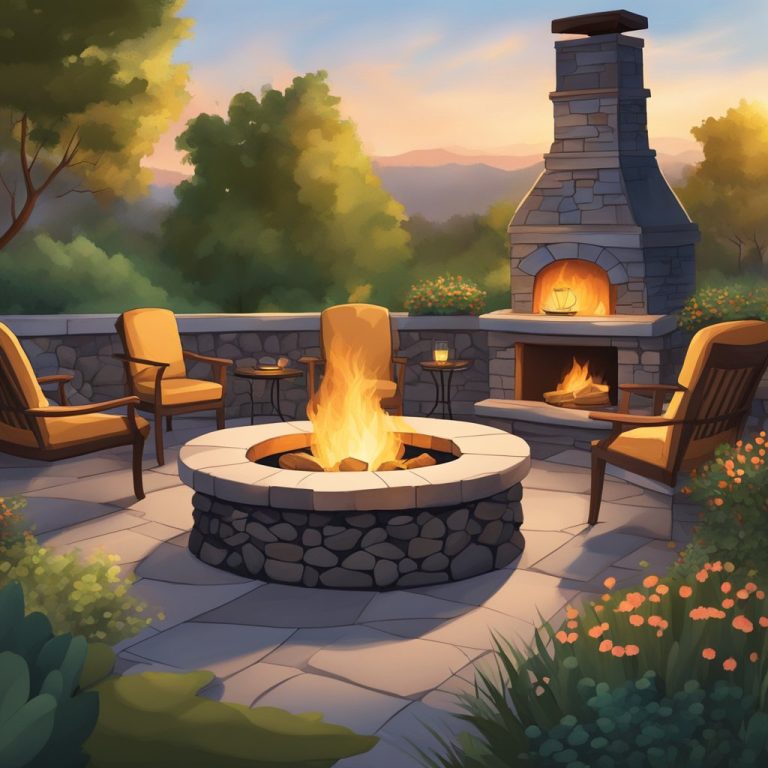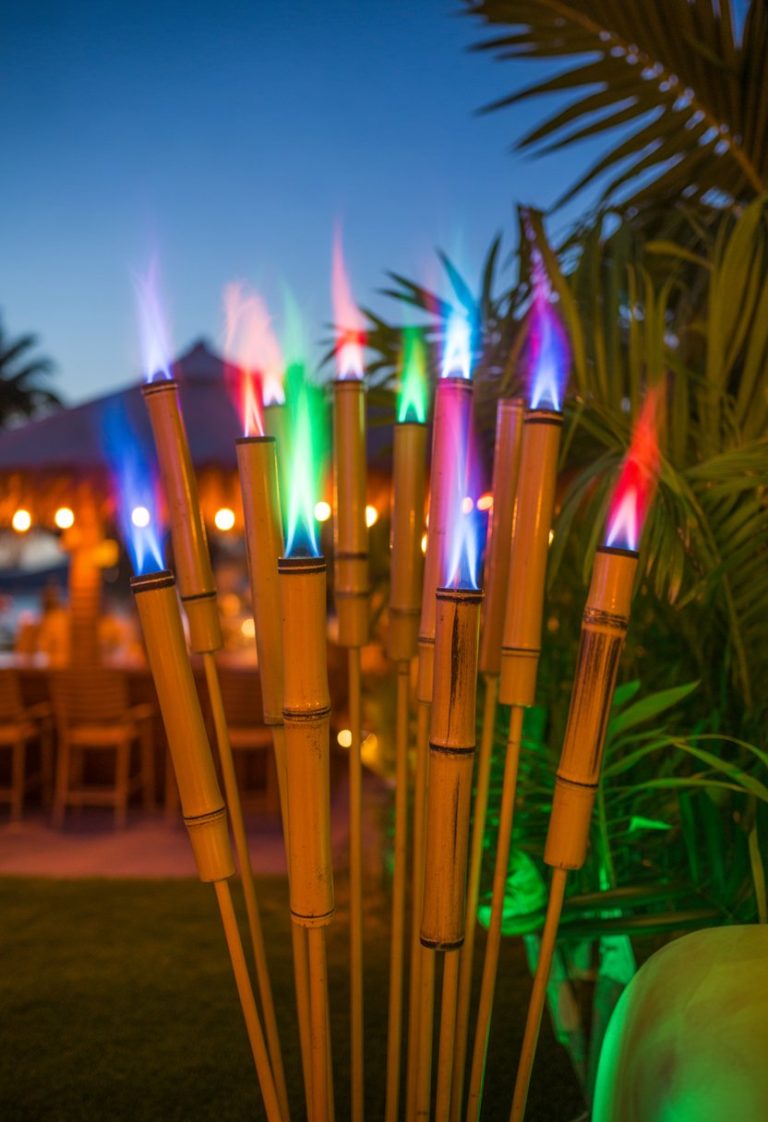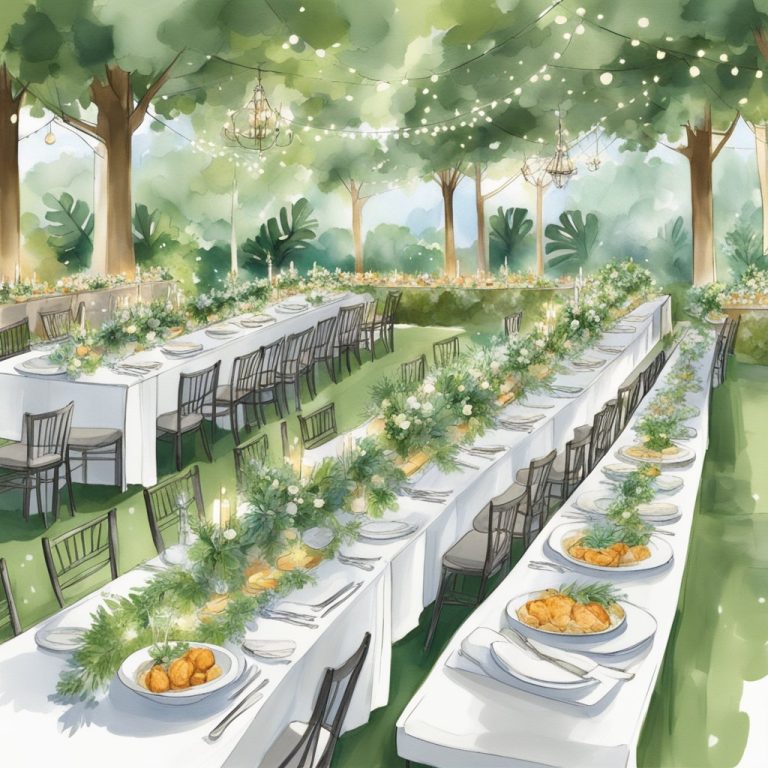Fire Pit Landscaping
Fire Pit Landscaping: 25 Ideas Your Neighbors Will Envy

A fire pit brings warmth and character to any backyard, but the real magic happens when it blends seamlessly into the landscape. Fire pit landscaping turns a simple flame into a centerpiece that enhances your garden design while creating a welcoming place to gather. With the right mix of plants, stonework, and layout, your outdoor fire pit becomes more than a feature—it becomes part of the environment.
This article explores outdoor fire pit ideas that highlight the balance between natural elements and functional design. From garden fire pit inspiration with seasonal color to outdoor fire pit designs that pair with water features or rustic stone, each idea shows how to create a space that feels both inviting and practical. Whether you want a cozy woodland niche, a modern minimalist look, or a vibrant seasonal showcase, these fire pit garden approaches offer a starting point for your own backyard retreat.
Lavender Border Haven
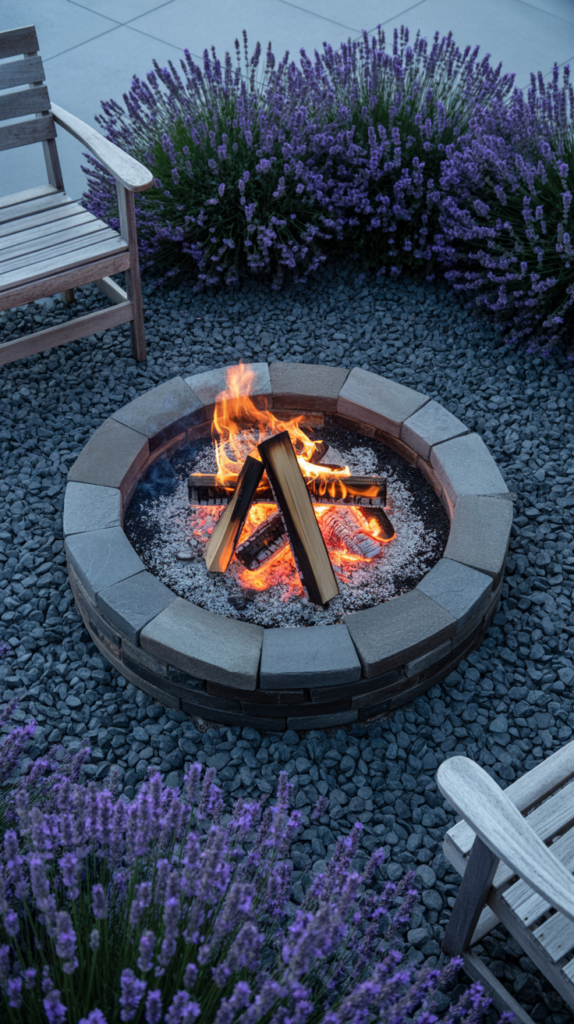
Surrounding your fire pit with lavender creates a calm and inviting setting. The soft purple blooms bring steady color, while the plant’s natural fragrance adds a relaxing layer to your outdoor space.
Lavender thrives in sunny spots and handles dry soil well, making it a good match for the warmth of a fire feature. Its resilience means less worry about heat stress near your fire pit.
The flowers also attract bees and butterflies, bringing more life to your yard. This simple border not only frames the fire pit but also supports pollinators in your garden.
Placing lavender along the edge of the seating area helps define the space without making it feel crowded. The result is a border that looks neat, smells pleasant, and works well with a fire pit’s natural heat.
Gravel and Grass Balance

Pairing gravel with ornamental grasses creates a clean yet natural look around your fire pit. The gravel defines the seating area, while the grasses soften the edges and bring in color and movement. This balance keeps the space structured without feeling too rigid.
Gravel provides a solid, level surface for chairs and pathways. It also drains well and requires little upkeep compared to other ground covers. Adding grasses nearby introduces a living element that contrasts with the stone texture.
Ornamental grasses sway in the breeze, adding a sense of life and calm to the setting. Their shapes and shades vary, giving you options from tall, airy plumes to compact clumps. This variety helps the fire pit area blend naturally with the rest of your yard.
The mix of gravel and grasses also keeps maintenance simple. Gravel rarely needs more than the occasional raking, while most grasses only need trimming once or twice a year. Together, they create a welcoming fire pit area that feels both tidy and relaxed.
Stonework Terraces

Stonework terraces make a sloping yard more usable and give your fire pit a solid place to stand. By leveling the ground with stone retaining walls, you create flat areas that feel stable and inviting. Each terrace can serve a purpose, from seating to greenery.
Built-in seating along the retaining walls keeps the space organized and comfortable. Stone benches blend with the landscape and reduce the need for extra furniture. This makes gatherings around the fire pit easier to enjoy.
Plantings that cascade over the walls soften the hard edges of the stone. Adding greenery brings color and life while helping the terraces feel more natural. Low-maintenance plants work well and keep the area looking fresh.
Layering terraces also helps define zones in your yard. One level may hold the fire pit, while another supports dining or lounging. This design makes the slope feel intentional instead of difficult to manage.
Water Feature Contrast

Placing a fire pit near a small water feature creates a balanced outdoor setting. The fire brings warmth and light, while the water adds movement and calm. This mix makes the space feel more inviting.
The crackling of the fire pairs well with the gentle sound of running water. The two sounds together create a relaxing atmosphere that feels natural. It helps make your backyard feel like a retreat.
A fountain, pond, or small waterfall works well next to a fire pit. The water element cools the look of the space, while the fire adds brightness. This contrast keeps the area from feeling too heavy or one-dimensional.
Paths, stones, or gravel can connect the fire pit area to the water feature. This simple design step makes the space easier to enjoy. It also helps the two elements feel like they belong together.
Seasonal Color Beds

Planting seasonal flowers around your fire pit keeps the space lively all year. Bright blooms frame the seating area and make the fire pit feel like part of the garden instead of a separate feature.
In spring, bulbs such as tulips or daffodils bring fresh color after winter. Their early blooms add energy and make the space feel welcoming during cool evenings.
Summer annuals like petunias, marigolds, or zinnias provide bold color through the warm months. These flowers thrive in the heat and create a cheerful backdrop for outdoor gatherings.
When the weather cools, fall mums keep the area vibrant with their rich tones. Their long-lasting blooms carry color into late autumn, extending the life of your garden display.
Rotating flowers each season keeps the fire pit setting interesting. This approach also helps maintain healthy soil and prevents the space from looking bare at different times of the year.
Rustic Woodland Niche
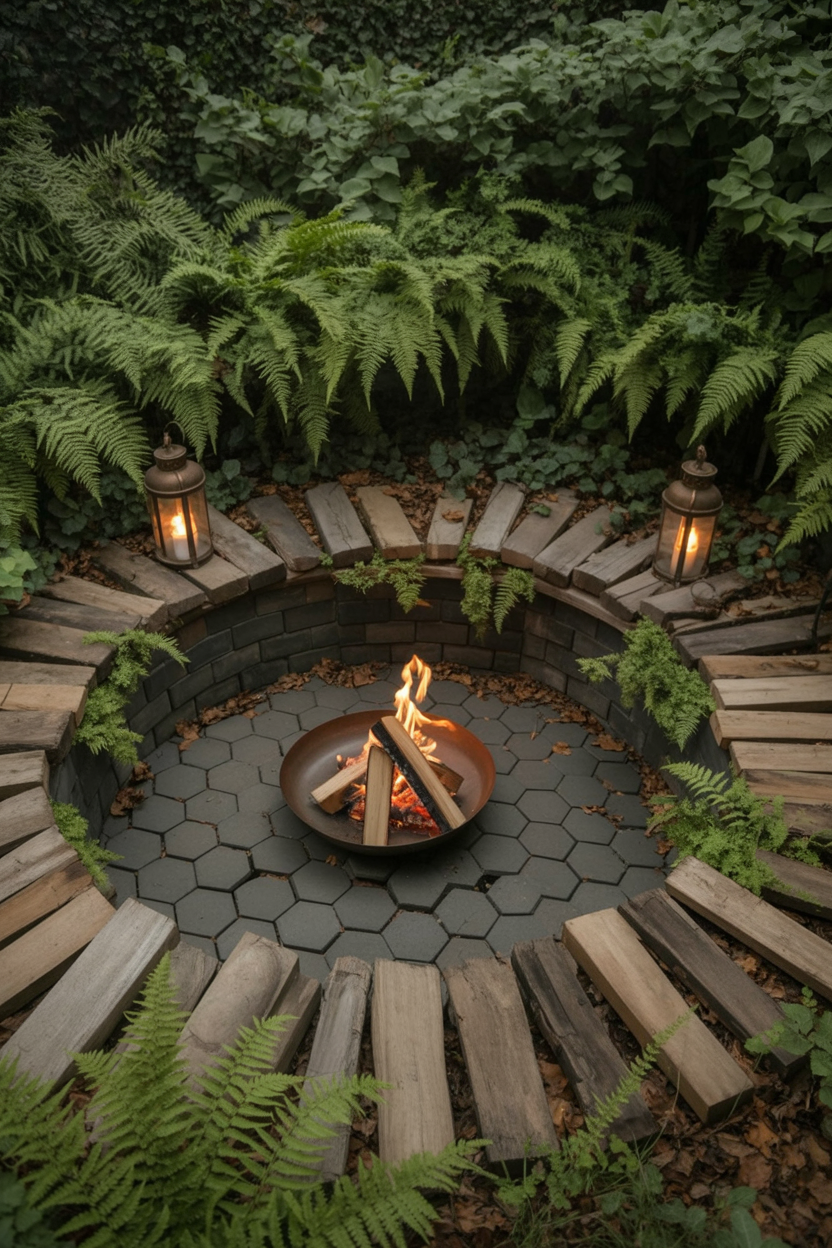
Set your fire pit along the edge of a wooded area to create a private, natural hideaway. The trees frame the space and provide shade, while the fire pit becomes the central feature for gathering.
Surround the seating area with ferns, hostas, and moss to blend the fire pit into the landscape. These plants thrive in shaded spots and soften the look of stone or metal fire pit designs.
Keep the layout simple with natural materials like rough stone or weathered wood. This style makes the fire pit feel like it belongs in the woodland setting rather than standing apart from it.
Add a few rustic chairs or benches for comfort without breaking the natural flow of the space. The result is a quiet retreat where the fire glows against a backdrop of greenery.
Modern Minimalist Planting

Modern minimalist planting keeps the focus on clean lines and simple design. Your fire pit becomes the centerpiece while the landscape works quietly in the background. This style feels calm and organized without extra clutter.
Boxwood shrubs give structure and balance. Their neat shapes frame the fire pit area and create a sense of order. Pair them with ornamental grasses to soften the edges and bring in gentle movement.
Gravel paths or ground cover add texture without overwhelming the space. The neutral tones highlight the sleek materials of a modern fire pit, whether it’s steel, concrete, or stone. This balance makes the fire pit stand out even more.
Fewer plant types mean less maintenance and a cleaner look. With only a few well-chosen elements, your outdoor area feels open and inviting. The result is a simple, modern retreat that still feels warm and welcoming.
Succulent Surrounds

Succulents bring a clean, structured look to a fire pit area while staying low maintenance. Their ability to store water makes them a smart choice for hot, dry climates where other plants may struggle.
Place agaves or sedum around a stone fire pit to create a natural frame that feels modern and simple. Their shapes add interest without overwhelming the space.
Mix different varieties with gravel or small rocks to keep the design cohesive. The combination of plants and stone helps the fire pit blend into the landscape.
Arrange succulents in clusters rather than straight lines for a more relaxed feel. This layout softens the edges of the fire pit while keeping the area easy to care for.
Choose heat-tolerant species that thrive in direct sun to avoid constant upkeep. With the right mix, your fire pit area stays attractive through every season.
Fragrant Evening Garden

Surround your fire pit with plants that release their scent after sunset. Flowers like nicotiana and night phlox open in the evening and fill the air with a light fragrance. Their blooms add both beauty and a calming atmosphere to your outdoor space.
Mix these fragrant plants with low-maintenance greenery for balance. Soft grasses and small shrubs create structure while letting the flowers stand out. This combination keeps the area inviting without feeling crowded.
Add seating close enough to enjoy the scent and warmth together. Comfortable chairs or benches let guests relax while the fragrance drifts through the air. The firelight highlights the blooms, making the space feel welcoming at night.
Choose planters or flower beds that frame the fire pit without blocking the view. This setup keeps the area open while still surrounding it with color and fragrance. Simple pathways or pavers make the garden easy to move through while keeping it tidy.
Native Meadow Integration

Planting native meadow species around your fire pit creates a soft, natural setting that feels relaxed and inviting. The mix of grasses and wildflowers blends the fire feature into the landscape instead of making it look separate or forced. This approach makes the area feel more like part of the land.
Native meadow plants also support local pollinators such as bees and butterflies. By choosing species that thrive in your region, you help provide food and shelter for wildlife while keeping maintenance low. These plants adapt well to local conditions, which means less watering and fewer chemical inputs.
The natural growth patterns of meadow plants add movement and variety to the space. Tall grasses sway with the wind, while seasonal blooms bring changing colors through the year. This creates a calm, ever-changing backdrop for evenings by the fire.
Using meadow plants also reduces the need for large amounts of lawn or formal landscaping. The result is a fire pit area that feels both functional and ecologically friendly. It encourages gathering while also supporting the broader environment around your yard.
Wildflower Ring
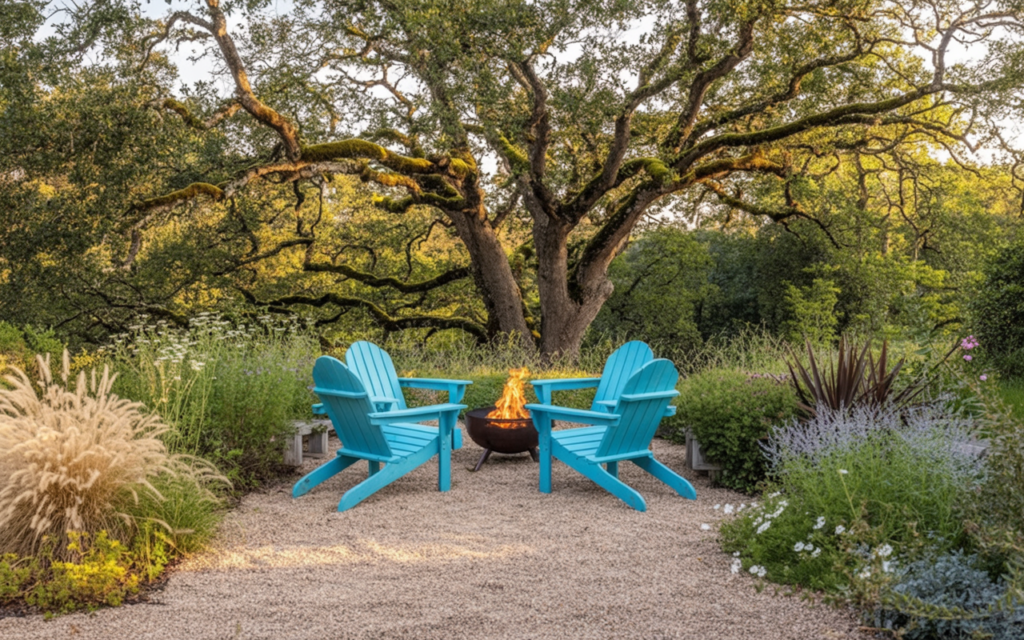
Surrounding your fire pit with a ring of wildflowers creates a relaxed and natural look. The mix of colors and textures softens the hard edges of stone or metal, making the space feel more inviting. It blends the fire feature into the landscape instead of making it stand out alone.
A wildflower ring is low-maintenance compared to traditional garden beds. Once established, many native flowers need little watering or care. This makes it a practical choice if you want beauty without constant upkeep.
The blooms also attract pollinators like bees and butterflies. Their movement brings life to the area and supports local ecosystems. Watching them while sitting by the fire adds a quiet, calming detail to the experience.
Seasonal changes keep the space interesting throughout the year. Bright spring flowers give way to summer color, while later blooms extend the display into fall. This shifting palette makes your fire pit area feel fresh and dynamic with little effort.
Water’s Edge Fire Pit

Placing a fire pit near a pond or reflecting pool adds a striking contrast between fire and water. The flames create warmth and movement, while the still surface of the water brings calm balance to the scene. This mix of elements makes the space feel lively yet peaceful.
At night, the glow of the fire reflects across the water, doubling the effect of the light. The gentle ripples make the reflection shimmer, which adds depth and interest to your outdoor area. Positioning the pit a safe distance from the water keeps the fire practical and secure.
Surrounding plants help tie the design together. Water lilies or iris near the edge of the pond bring color and texture, while low grasses soften the transition between stone and water. These choices keep the setting natural while still framing the fire pit as the focal point.
Comfortable seating nearby makes the area inviting for small gatherings. Chairs or benches placed to face both the fire and the water let guests enjoy the scene from more than one angle. This setup encourages relaxation and conversation in a memorable outdoor setting.
Evergreen Frame

Evergreens give your fire pit area a steady backdrop through every season. Boxwood, yew, or dwarf conifers create a natural frame that stays green even in the coldest months. This steady color helps the space feel inviting when the rest of the yard looks bare.
Placing evergreens around the fire pit also helps define the area. The plants act like living walls, making the space feel more private and enclosed. Their dense form adds structure without needing much upkeep.
In winter, when deciduous plants drop their leaves, the evergreens keep the space from looking empty. Their steady foliage pairs well with the warm glow of the fire, giving the area a balanced look.
Mixing different shapes and sizes of evergreens adds variety. Low boxwood borders, paired with taller yews or conifers, create layers that frame the fire pit naturally. This setup works in both small and large yards.
Herb Garden Integration
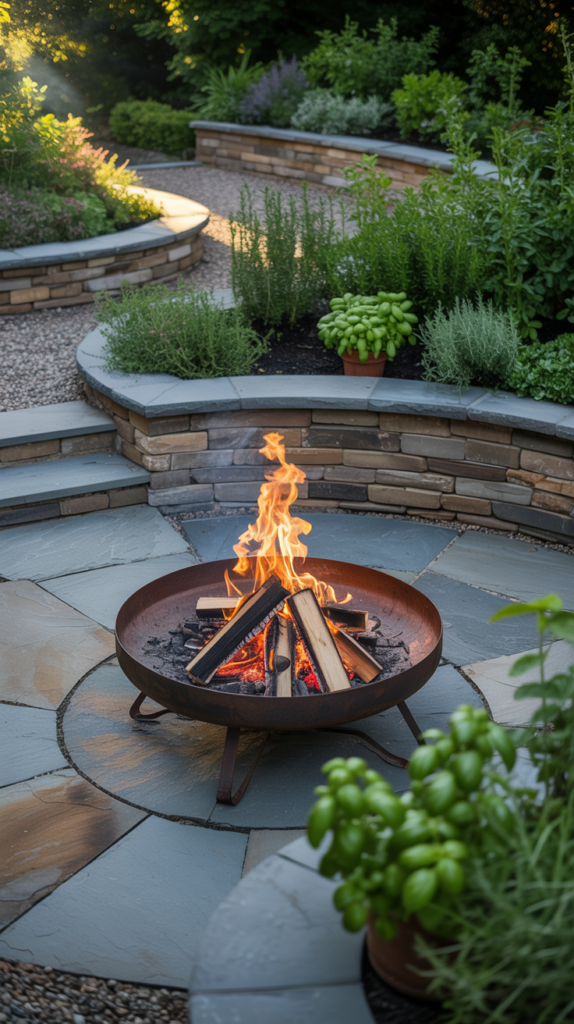
Planting herbs around your fire pit adds both beauty and function to the space. Rosemary, thyme, and sage bring fresh scents that make evenings more enjoyable while also serving as useful ingredients for cooking. Their greenery softens the hard edges of stone or metal fire pit designs.
These herbs hold up well in sunny areas and require little water once established. Their durability makes them a smart choice for low-maintenance landscaping. With the right placement, they thrive in the same conditions that keep your fire pit area open and dry.
Arrange herbs in clusters or along pathways leading to the fire pit. This creates a natural border that feels inviting and practical. When guests gather, the plants add fragrance that blends with the warmth of the fire.
Keeping herbs close to the fire pit also makes them easy to snip for grilling or seasoning food outdoors. Their compact size prevents them from overwhelming the space, while still adding a lively, green accent.
Rock Garden Fire Pit
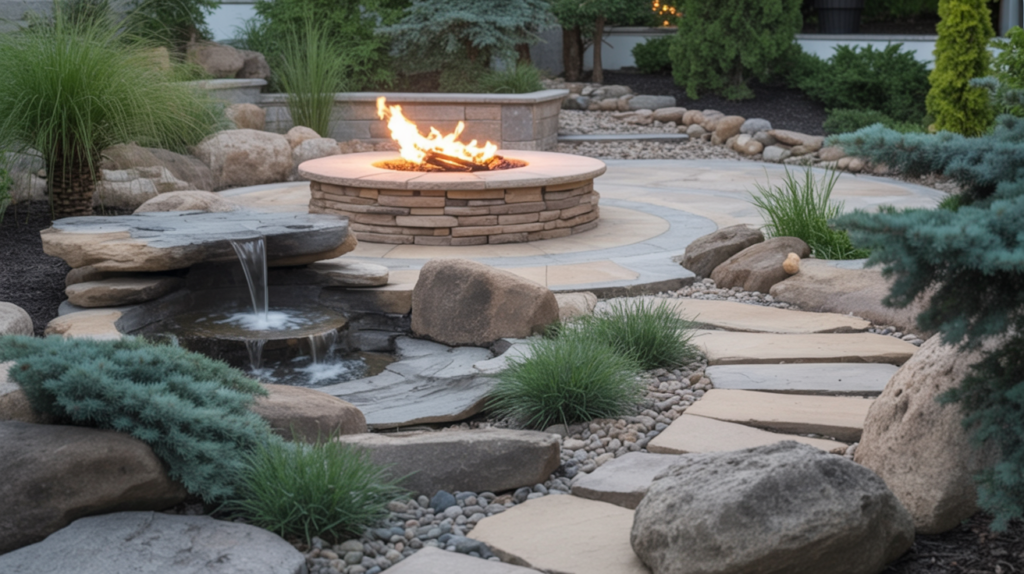
A rock garden fire pit blends natural stone with low-maintenance landscaping. The mix of gravel, boulders, and smaller rocks creates a textured base that feels simple and inviting. This style works well in both large and small yards.
Pairing the fire pit with succulents or alpine plants adds greenery without needing heavy upkeep. These plants thrive in rocky terrain and bring color and shape to the space. Their hardy nature means less watering and care.
Large sculptural boulders placed around the pit can act as natural seating or visual anchors. They frame the fire area while giving the design a grounded look. Smaller stones or gravel paths help define walkways and keep the area tidy.
Xeriscape plantings fit naturally with this setup. By choosing drought-tolerant plants, you reduce maintenance while keeping the space attractive. The combination of stone and plants creates a balanced outdoor feature that feels practical and comfortable.
Seasonal Bulb Border

Planting a border of bulbs around your fire pit brings fresh color each spring. Tulips, daffodils, and alliums create cheerful blooms that frame the space and make it feel more inviting after winter. Their growth signals the start of outdoor evenings by the fire.
Layering bulbs with summer perennials keeps the area lively after spring flowers fade. Perennials like coneflowers or black-eyed Susans fill in the gaps and extend the season of interest. This mix keeps your fire pit border from looking bare in warmer months.
Choose bulbs that thrive in your climate and plant them in clusters for a natural look. Staggering bloom times adds variety, so the space changes week by week. The result is a border that feels dynamic without much extra work.
Adding evergreens or ornamental grasses nearby provides structure when bulbs are dormant. These plants give the fire pit area year-round definition while bulbs and perennials rotate through their cycles. This approach makes your border both practical and attractive.
Stone Terrace Fire Pit
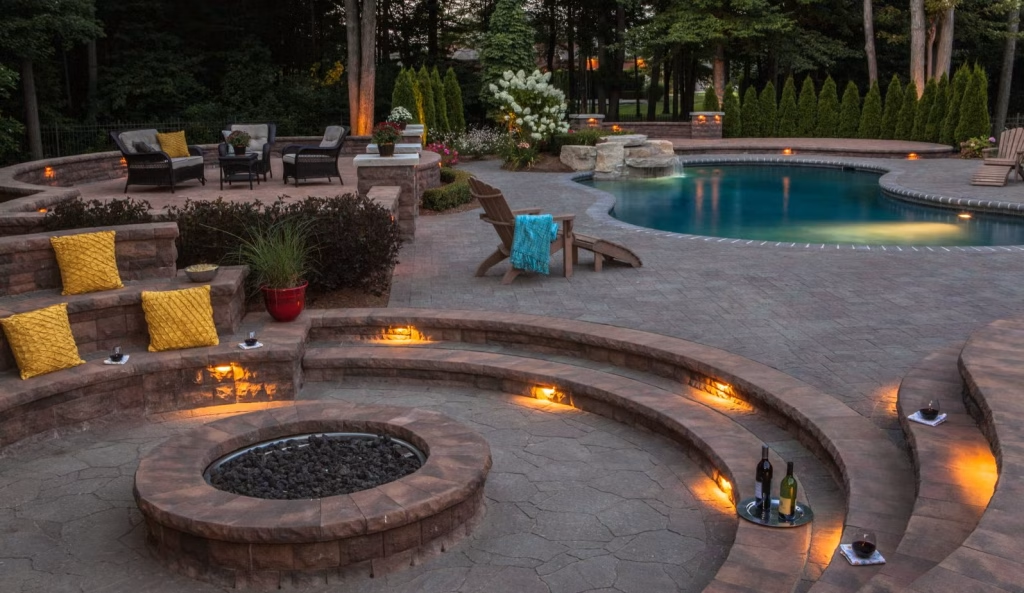
A stone terrace fire pit works well on a sloped yard where flat space is limited. By building landings into the slope, you create natural levels that feel organized and inviting. Each terrace can serve a purpose, with one level dedicated to the fire pit area.
Stone retaining walls help hold the slope in place while also acting as built-in seating. This keeps the space functional without needing to add many chairs. The stone materials blend into the landscape and give the area a clean, solid look.
Placing the fire pit on a middle landing creates a central gathering spot. The levels above and below can be used for planting, dining, or lounging. The result is a layered outdoor space that feels both practical and connected.
Lighting along the steps and walls adds safety and makes the terrace easy to use after dark. Simple landscaping, such as shrubs or low plants, softens the stone and adds color. This setup helps your fire pit feel like part of the yard instead of a separate feature.
Vine-Covered Pergola with Fire Pit

A pergola draped with vines creates a cozy setting for your fire pit area. The overhead beams frame the space, while the greenery softens the structure and adds a natural look. Sitting below feels calm and private, even in an open yard.
Climbing plants like wisteria, clematis, or grapevine add shade during the day and a lush backdrop at night. Their growth over the pergola helps define the fire pit zone as a separate outdoor room.
The fire pit beneath provides a warm gathering spot while the vines filter light and create gentle movement in the breeze. The mix of flame and foliage makes the space feel inviting without being overwhelming.
Adding simple seating around the fire pit completes the design. Chairs or benches placed under the pergola encourage conversation and make the area useful in every season.
Woodland Boardwalk Fire Deck

Not every fire pit needs to sit directly on the forest floor. In fact, one of the most innovative ways to integrate fire into a woodland garden is by creating a floating boardwalk-style deck. This design approach raises the fire area above the roots and moss, protecting the fragile ecosystem while adding a refined architectural touch.
Imagine stepping onto a slim hardwood deck — built from ipe or thermally modified ash — that seems to hover among the trees. A sleek smokeless fire insert sits flush within the decking, surrounded by built-in ledge seating instead of freestanding chairs. Slim corten edging defines the perimeter, while subtle bronze path lights graze the wood surface to make it glow after sunset.
Beneath the deck, the natural woodland understory is left untouched, a living carpet of mosses, ferns, and shade-loving groundcovers. Seasonal shifts become part of the design: fresh green fronds in spring, golden leaf fall in autumn, and a serene mossy stillness in winter. It’s an elevated way to enjoy a fire pit in a forest setting, offering modern comfort while maintaining the integrity of the landscape.
Mediterranean Courtyard Fire Pit
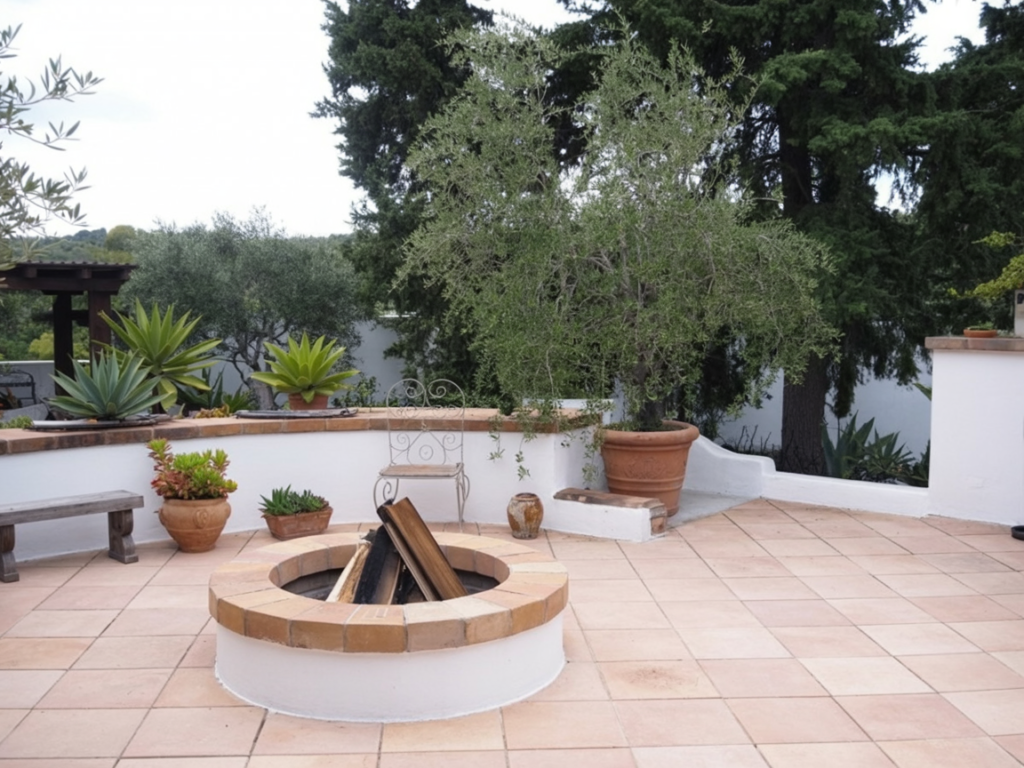
A Mediterranean courtyard fire pit creates a warm and inviting space for outdoor evenings. The style blends natural elements with simple design, making your backyard feel relaxed and timeless.
Pair the fire pit with olive trees to bring in a classic Mediterranean look. Their silvery-green leaves add texture and shade while keeping the space calm and natural.
Lavender works well around the seating area, adding color and a subtle fragrance. The low-growing plants help soften the edges of stone or gravel pathways.
Terracotta pots filled with herbs or succulents give the courtyard an authentic feel. Place them near the fire pit for a rustic accent that also ties the space together.
Stucco walls or tiled hardscapes complete the setting. The firelight reflects off these surfaces, creating a soft glow that feels both simple and elegant.
Waterfall Accent
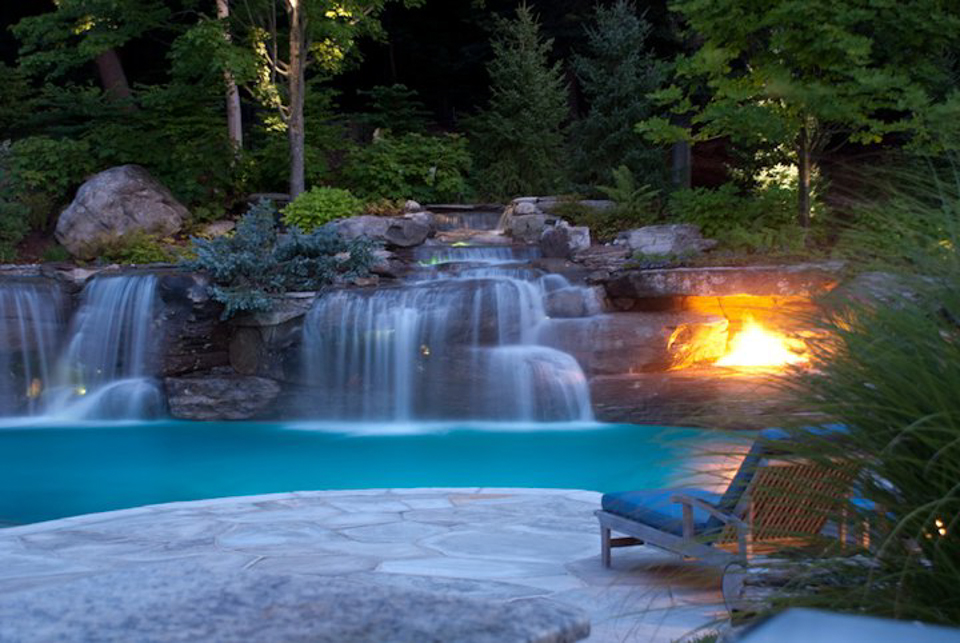
Placing a small waterfall near your fire pit adds a calm and balanced feel to your yard. The steady sound of flowing water pairs well with the soft crackle of fire, giving your space a natural rhythm.
A trickling feature does not need to be large to make an impact. Even a modest stream beside the seating area creates a soothing backdrop for conversation and relaxation.
Positioning the waterfall close to the fire pit gives you two focal points in one area. The movement of water draws the eye during the day, while the fire becomes the highlight at night.
Surrounding the setup with stone or greenery helps blend both elements into the landscape. This makes the area feel inviting without overwhelming the rest of your yard.
Adding simple lighting near the water feature extends its effect into the evening. The glow of the fire mixed with subtle reflections from the water creates a calm and welcoming atmosphere.
Zen-Inspired Gravel Garden

A Zen-inspired gravel garden creates a calm backdrop for your fire pit. The focus stays on clean lines, open space, and natural textures that encourage a sense of balance. Gravel makes a simple base that feels uncluttered and easy to maintain.
Placing a fire pit in the center of a raked gravel area gives the space a clear focal point. The circular patterns in the gravel echo the shape of the fire pit and create a sense of order. Large stones or boulders placed nearby add weight and structure.
Low plants, such as moss or small evergreens, can frame the area without overwhelming it. Their subtle greenery softens the look and blends naturally with the hardscape. Lighting around the fire pit helps extend the garden’s use into the evening.
This style works well if you want a quiet retreat for reflection or small gatherings. The gravel surface improves drainage and keeps the area neat with little upkeep. With simple design choices, your fire pit becomes part of a peaceful outdoor setting.
Four-Season Planting Scheme
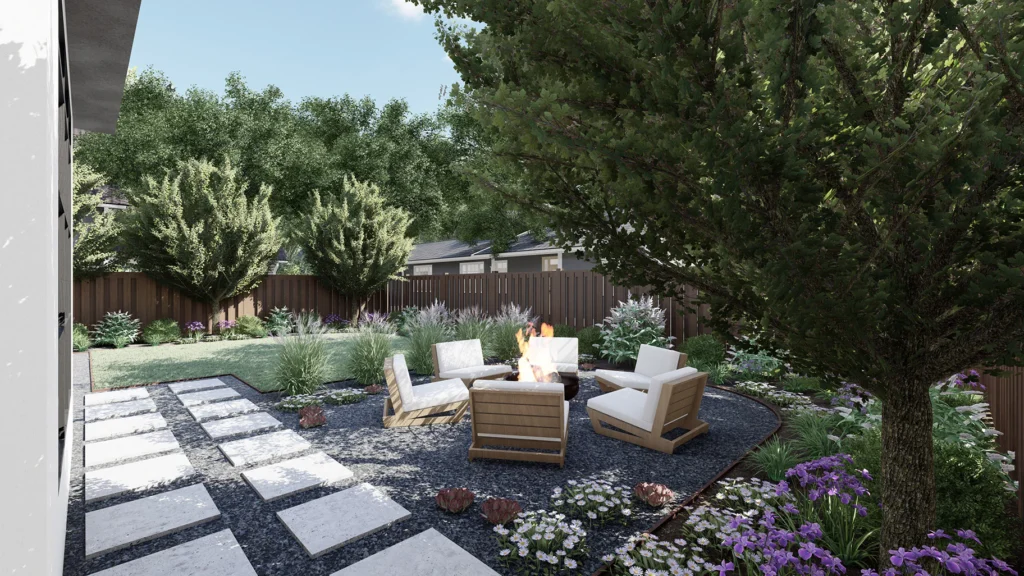
A fire pit area looks more inviting when plants provide interest in every season. By mixing different types of plants, your space stays colorful and lively instead of looking bare during colder months.
Evergreens give steady greenery through winter, keeping the fire pit area from feeling empty. Their structure also adds a natural backdrop for other plants as the seasons change.
Ornamental grasses bring movement and texture, especially in fall when their seed heads stand out. They also pair well with stone or gravel surfaces often found around fire pits.
Flowering shrubs add bursts of color in spring and summer. Varieties with long bloom times or repeat flowers keep the space cheerful during warm evenings outdoors.
Bulbs planted around the fire pit provide early spring interest. As they fade, other plants take over, creating a smooth transition from one season to the next.
By combining these plant types, your fire pit area stays balanced and appealing no matter the time of year. Each group plays a role in keeping the landscape fresh, colorful, and welcoming.
Sculptural Stonework Centerpiece
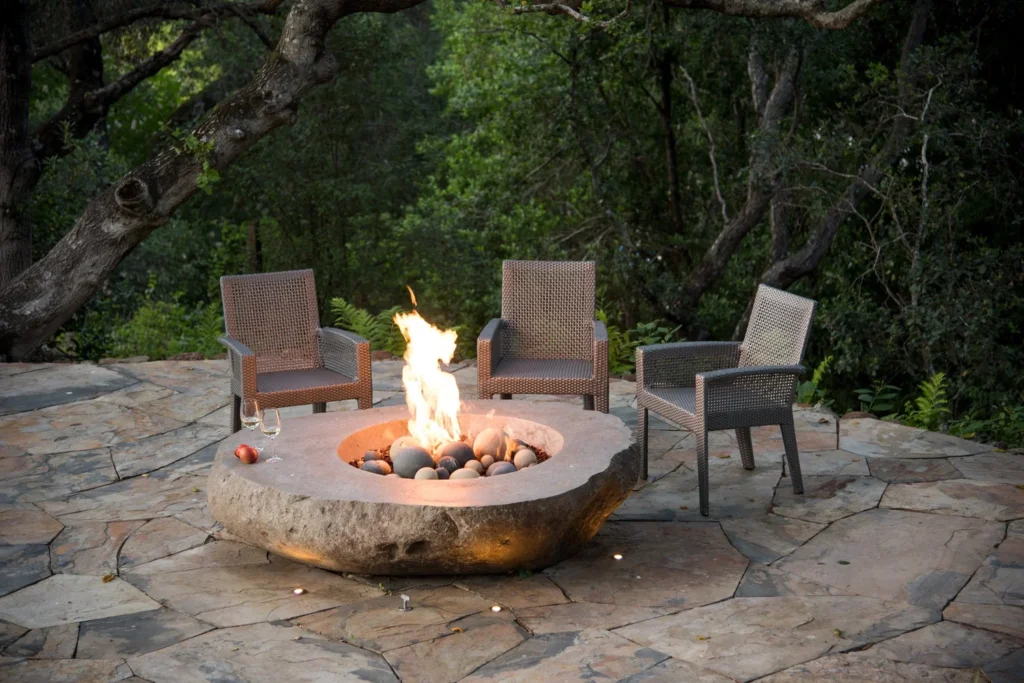
Transform your fire pit into a sculptural element by using hand-carved stone or large stone slabs. This approach makes the fire pit itself the main feature of the space rather than just a functional piece. The natural texture and weight of stone create a grounded, timeless look.
Choose bold shapes or monolithic blocks to frame the fire. Their scale and presence give the area a sense of permanence and design intention. Even simple forms, when carved from stone, feel striking and purposeful.
Pair the stonework with simple seating or low plantings so the fire pit remains the star of the space. The sculptural quality of the stone will draw attention even when the fire is not lit.
This style works well in both modern and rustic landscapes. Clean-lined slabs complement contemporary yards, while rough-hewn stone fits naturally into more traditional or woodland settings.
Seasonal Foliage Showcase
Adding seasonal plants around your fire pit keeps the space lively throughout the year. Bright leaves, colorful blooms, and textured greenery create a setting that feels fresh and inviting in every season.
Maples bring rich reds and oranges in the fall, giving your fire pit area a warm backdrop that pairs well with cooler evenings. Their shifting colors create visual interest without needing extra décor.
In spring, flowering shrubs like azaleas or lilacs add soft colors and fragrance near the fire pit. These plants help mark the change of season while making the space feel more welcoming for gatherings.
Summer works well with ornamental grasses or evergreens that stay vibrant during hot months. Their steady greenery balances the brighter seasonal plants and keeps the area looking full.
Winter landscapes benefit from hardy plants such as holly or boxwood. Their structure and evergreen leaves provide consistency, so your fire pit area never feels empty.
Design Principles for Fire Pit Landscaping
A well-planned fire pit area depends on safe placement, durable materials, and comfortable seating. Each choice affects how the space looks, how long it lasts, and how enjoyable it feels when people gather around the fire.
Balancing Safety and Style
Safety starts with location. Place your fire pit at least 10 feet from buildings, fences, and overhanging trees. Check local codes to confirm rules about open flames and fuel types.
Choose non-flammable surfaces around the pit, such as gravel, stone, or concrete. Avoid wood decks unless you add a fire-resistant base. Keep a bucket of water or a fire extinguisher nearby for emergencies.
Safety does not mean giving up style. A sunken pit lined with stone creates a clean look while reducing wind hazards. Low-profile designs blend into the yard while still keeping flames contained. Adding a border of pavers or bricks also defines the space and prevents stray sparks from reaching grass or mulch.
Choosing Materials That Last
Durable materials protect your fire pit from weather and frequent use. Stone, brick, and concrete blocks handle high heat and resist cracking. Metal fire bowls or inserts add strength but should be made from stainless steel or cast iron to avoid rust.
Think about climate when selecting materials. In wet regions, sealed stone or pavers prevent water damage. In colder areas, frost-resistant blocks stop crumbling during freeze-thaw cycles.
It helps to mix materials for function and appearance. For example:
| Material | Benefits | Considerations |
|---|---|---|
| Natural Stone | Long-lasting, natural look | Can be costly |
| Brick | Classic style, heat resistant | May chip over time |
| Concrete Pavers | Affordable, easy to install | Needs sealing |
| Metal Insert | Protects inner walls | Can discolor with heat |
Integrating Seating and Gathering Spaces
Seating defines how people use the fire pit area. Built-in stone benches create permanence, while movable chairs make the layout flexible. Arrange seats in a semi-circle or full circle to keep everyone close to the fire.
Comfort matters as much as placement. Add cushions with weather-resistant fabric for longer sitting. Keep at least 3 feet between the fire pit and seating edge for safety and ease of movement.
Think about group size. A small pit with two chairs works for quiet evenings, while a larger circle with mixed seating fits family gatherings. Adding side tables or low walls doubles as extra surfaces for food and drinks, making the space more practical.
Enhancing Ambiance Around Your Fire Pit
A fire pit feels more inviting when the space around it encourages relaxation and comfort. Small design choices like lighting, greenery, and decor help create a balanced setting that feels warm and welcoming.
Lighting Solutions for Evening Enjoyment
Proper lighting makes your fire pit area safer and more enjoyable after dark. String lights overhead provide a soft glow that spreads evenly without overpowering the fire. Lanterns placed on tables or along pathways add both style and function.
For a modern look, install low-voltage LED lights around seating areas or under benches. These lights highlight the layout while preventing tripping hazards. Solar-powered stake lights also work well along walkways, offering an energy-efficient option that requires no wiring.
If you prefer a cozy setting, consider candlelight. Grouping candles inside glass holders or hurricane lamps creates a gentle flicker that complements the fire. Mixing different lighting types keeps the space flexible, whether you’re hosting a group or relaxing alone.
Incorporating Plants and Greenery
Plants soften the hard edges of stone, brick, or metal fire pit designs. Low shrubs or ornamental grasses create a natural border that feels inviting without blocking airflow. Evergreen plants provide year-round greenery, while seasonal flowers add changing bursts of color.
Climbing plants on a pergola or trellis near the fire pit bring height and texture. Vines such as jasmine or clematis add visual interest and a mild fragrance. For a low-maintenance option, potted plants let you move greenery around as needed.
When placing plants, keep them at a safe distance from flames and sparks. Using containers made of clay, stone, or metal reduces fire risk. Mixing plant sizes and textures creates a layered look that feels balanced and natural.
Accessorizing With Outdoor Decor
Decor pieces tie the fire pit area together and make it feel like an extension of your living space. Cushioned chairs, weather-resistant rugs, and sturdy side tables create comfort and function. Adding throw pillows in durable fabrics introduces color without much effort.
Outdoor art, such as metal wall hangings or sculptures, adds personality. A few well-placed accents, like ceramic planters or woven baskets, make the space feel finished without clutter.
For cooler nights, keep a storage box or bench stocked with blankets. This small detail makes gatherings more comfortable and encourages longer stays by the fire. Simple, durable accessories keep the area both practical and inviting.

